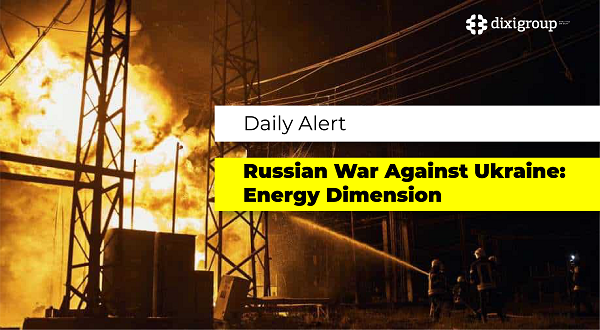Russia's coal abyss: how sanctions are killing one of its key industries
How Russia's coal sector is weathering the sanctions storm

The Russian coal industry has plunged into a systemic crisis that encompasses not only economic, but also social and environmental dimensions. According to the Federal Statistics Service of the Russian Federation, in 2024 only half of the industry’s companies remained profitable, and in 2025 the situation continues to deteriorate rapidly. Bloomberg reports that PJSC Mechel, one of the largest market players, has already reduced production and warned of a 25% drop in sales, as each ton of coal brings losses. Dozens of mines in Siberia have stopped working, leaving thousands of workers without a livelihood.
Ukrainian Energy found out what is happening to Russian coal.
The crisis of the decade
The Russian coal industry is experiencing the most acute crisis in recent decades — economic, social and technological. According to a report by The Moscow Times, in the first quarter of 2025, the net loss of coal companies reached 79.9 billion rubles. The daily amount of losses is about 900 million rubles.
Less than 40% of companies made a profit, and it fell three times compared to last year. “In terms of the volume of losses, this is a record in the entire history of Rosstat statistics,” the material says.
The industry is facing pressure from all sides. Demand from the key importer, China, has decreased by 13%, and coal prices have fallen to a four-year low.
The financial burden is increasing due to the cost of loans, which exceeds 20%. Previously, companies could raise funds at 3% from European banks or issue Eurobonds. Now these opportunities are blocked. “The coal industry is facing what can be called a perfect storm – all the problems have come together,” said Natalia Zubarevich, an expert on regional economics at Moscow State University.
The decline in profitability is triggered by several factors at once. First, world coal prices have fallen significantly – by 20% in 2025, compared to 2024, and almost three times – with peak figures in 2022. Second, China, which became the main buyer of Russian coal after the EU embargo, has reduced imports. Third, after three years of sanctions, Russian enterprises have lost access to modern equipment.
“We have lost the ability to forecast profits. Coal has become unprofitable, but stopping means laying off people and losing infrastructure,” says one of the heads of the SUEK holding, quoted by Russian media.
Sanctions have deprived Russian miners of access to equipment, leading to a technological collapse. Companies are resorting to “cannibalization” — dismantling equipment at unprofitable mines to keep at least one working.
“We are forced to dismantle one mine to give equipment to another — this is not development, this is survival,” admits one of the heads of the Sibantratsit holding.
“This is no longer just an economic crisis — this is the degradation of the industry,” says Russian economist Igor Lipsits. In some regions, according to him, stopping mining means losing the entire budget.
Regions want to live
Regions with high dependence on the coal industry are the first to be hit. The Kemerovo region reported a 20% deficit after a decrease in tax revenues. Local authorities are already cutting allowances for doctors and educators. In Minusinsk (Krasnoyarsk Krai), more than 1,000 families have been left without a livelihood after three mines were shut down.
“We are not receiving salaries or social benefits. Some have already been forced to leave the region,” says a local resident, quoted by Russian media.
Safety is also at risk. In May, an accident occurred at the Vostochnaya mine in Yakutia, killing 17 workers. According to environmental organization Bellona, methane levels in the surrounding areas have increased by 28% due to uncontrolled emissions from abandoned mines. The lack of proper monitoring is a consequence of budget cuts for technical services.
The Russian government recognizes the crisis. As Russian Deputy Energy Minister Dmitry Islamov stated, “the industry needs comprehensive support — economic, financial, and logistical.” At a meeting of the Federation Council, it was announced that 51 mines have already stopped working or are on the verge of stopping. Emergency measures include deferring tax obligations, transport subsidies, and debt restructuring. However, these tools do not solve the key problem - the loss of markets.
According to experts, by the end of the year, the industry's total losses may exceed 350 billion rubles, and the debt may reach 1.4 trillion.
Tighten your belt
The National Welfare Fund of the Russian Federation is rapidly shrinking. According to the RANEPA (Russian Academy of National Economy and Public Administration under the President of the Russian Federation), as of June 1, the Fund had 2.8 trillion rubles ($31 billion), which is the lowest since 2019. At the same time, it is noted that over the three years of the war against Ukraine, the volume of reserves has more than halved in rubles and tripled in dollars: from 113.5 billion to 37.4 billion. In May, the Russian Ministry of Finance spent 35.9 billion rubles ($400 million) from the Fund to cover the budget deficit, 532 billion ($5.9 billion) to finance state projects, and another about 50 billion rubles ($556 million) on classified projects. The Fund now has $21.2 billion in assets and 139.5 tons of gold, although before the war, the reserves exceeded 400 tons. According to Ilya Sokolov from the RANEPA, these balances make it possible to compensate for losses from falling oil revenues, but in the event of a protracted crisis, the reserve will run out in less than a year.
Russian experts from the Gaidar Institute warn of the danger for the National Welfare Fund - the reserve may run out by 2026, which means a deficit in funding for both the industry and social programs and defense.
The state budget is also teetering on the edge. In the first half of 2025, the deficit amounted to 3.7 trillion rubles - six times more than in the same period of the previous year. "Actual expenses exceeded the forecast, and revenues, on the contrary, did not catch up," comments Natalia Milchakova, an analyst at Freedom Finance Global. - In the second quarter, the hole was almost twice as large as in the first - due to the fall in oil and gas revenues."
Against this background, Russian President Vladimir Putin announced the upcoming reduction in defense spending from 2026. “We will not spend like NATO on American weapons. We have our own model,” he was quoted as saying by The Telegraph.
At the same time, Economic Development Minister Maxim Reshetnikov admitted: “The country is on the verge of recession. Structural problems are growing.”
After the EU embargo and Western sanctions in 2022, there remains a need to look for new sales markets and adapt logistics. Initially, the market shifted to Asia — China, India — but restrictions and competition forced importers to look for cheaper alternatives, for example, from Indonesia and Australia. In 2023–2024, Russian coal exports fell by about 8–10%, and in 2024 prices also fell by 20% compared to 2023 and three times from 2022, according to the Foreign Intelligence Service.
Financially, the situation is extremely alarming: at the end of 2024, the industry lost 112.6 billion rubles ($1.4 billion) according to Reuters, and in the first quarter of 2025, another 79.9 billion rubles in losses, or about $0.9 billion per month.
At the same time, the dynamics are only getting worse: the number of unprofitable enterprises has increased from 50% to 62%. According to experts, this is the deepest crisis since statistics have been available - since the 1990s.
Logistical problems have become a key burden: transshipments in eastern ports have slowed down, trains are without spare parts, and transportation speeds have fallen to their lowest since 1991. Even domestic production has fallen — by 7.3% in Kuzbass, and Kutsyn coal production has fallen even more.
Payback for the war
Ukrainian experts predict long-term consequences. “The coal crisis is not limited to the economy — it is a blow to local stability, demography, and the governance system,” says DiXi Group analyst Andriy Voronkov. According to him, “the industry cannot survive without reform, and the state cannot survive without recognizing the failure of the previous development model.”
The global response is also changing. Countries that previously imported Russian coal are turning to alternatives — such as Indonesia, Australia, and South Africa. According to the International Energy Agency, by 2030, demand for coal in Europe will be halved, while Asia’s market share will be shaped by environmental standards. “Russia is not only losing markets — it is losing the future of the industry,” emphasizes Oleksandr Kharchenko, head of the Center for Energy Research.
“The crisis in the coal industry — one of the key sectors for the Russian economy — indicates deep systemic problems,” notes the Center for Countering Disinformation in Ukraine.
Social tension is growing — protests are being recorded in the regions over salary delays and reductions in benefits. In June, spontaneous rallies of workers who had not received payments for more than two months took place in southern Siberia. “We were simply abandoned. We worked for years, and now we can’t even buy bread,” Russian media quoted one of the miners from Novokuznetsk as saying.
The Russian coal crisis demonstrates the fragility of an authoritarian economy dependent on raw materials and international conditions. The loss of export markets, restrictions on technology, falling domestic demand and the devaluation of the ruble are shaping a new reality in which the energy sector is losing its role as the “locomotive” of the Russian economy. And although the Kremlin is trying to keep the industry afloat with artificial financing, the long-term consequences of this crisis are already being determined – in the form of job losses, a decline in living standards and a weakening of state control in strategic regions.
“The coal industry of the USSR ensured the country’s energy independence and was intended to supply the rapidly growing industry with energy and raw materials. When the industry, for known reasons, first disintegrated between sovereign states, and then without a pause began to decline almost everywhere, it turned out that the economy no longer needed such a quantity of energy resources. And every year, less and less. Therefore, reorientation to exports became a logical step, but at the same time the stability of all extractive industries fell sharply: their dependence on the external situation began to determine their very existence. And when politics was added to the economy, and in the light of the “wise” decisions of the authorities, which led to the loss of basic markets, the question became no longer about stability, but about survival. The domestic market is too small to ensure the survival of coal enterprises, and coal miners do not have the luxury of Gazprom to raise tariffs ungodly. Therefore, in a few more years, there will be very little left of the industry. And this is a considerable number of mono-profile cities and towns, critically dependent on mines and their work. But for obvious reasons, these "trifles" are of little concern to the authorities, who are preoccupied with "multipolarity" and other global fantasies. The country is simply consumable material for the global plans of our strategists. To paraphrase a well-known phrase: let 90 percent of the population die out, but 10 will definitely live to see our greatness. Well, or they will not live to see it - as luck would have it..." - says Russian publicist Anatoly Nesmiyan.
The analytical assessment shows: the crisis of the Russian coal industry is multidimensional. Economy, ecology, social stability and global risks are all intertwined in systemic collapse. For Ukraine, this process opens up new opportunities - both for strengthening energy security and for forming a narrative about the real consequences of aggression. Strong analytics - in this case, not just numbers, but a signal of a changing era.
Olena Marchenko, specially for "Ukrainian Energy"








